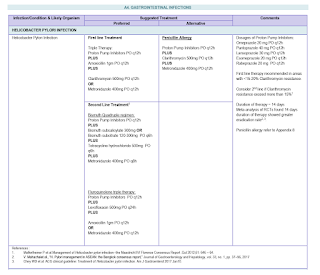H. Pylori Infection
Introduction
Helicobacter pylori infection is one of the most common causes of peptic ulcer disease, with 95% of duodenal and 70-80% of gastric ulcers associated with it.
- Helicobacter pylori is a spiral-shaped gram-negative bacterium transmitted through the oral to oral (more common) or faecal to oral route.
- Eradication of H. pylori infection reduces the possibility of developing gastric carcinomas.
Diagnosis
The presence of H. pylori should be confirmed before starting eradication treatment ("test and treat" strategy).
- Test for Helicobacter pylori infection in patients with a current or prior documented peptic ulcer or gastric malignancy, and
- Consider testing in patients with uninvestigated dyspepsia, patients on long-term low-dose aspirin, patients with unexplained iron deficiency anaemia and patients with idiopathic thrombocytopenic purpura.
Diagnosis may involve the
- 13C-urea breath test
- Most accurate non-invasive test
- Stool Helicobacter Antigen Test (SAT)
- Antibody testing (serology)
- May give false positive results because they indicate past and not necessarily current infection.
- Invasive testing via endoscopy
NOTE: Do not perform breath test or SAT within 2 weeks of proton pump inhibitor (PPI), or 4 weeks of antibiotics as these drugs supress bacteria and can lead to false negatives.
Treatment
Typically, triple therapy regimen comprises a proton pump inhibitor (PPI) and 2 antibacterial agents for 1-2 weeks.
After eradication, PPIs may be required for 4-8 weeks after triple therapy to promote further healing, especially if the ulcer was associated with bleeding or NSAID usage.

Comments
Post a Comment